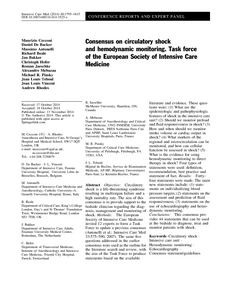Cecconi, M;
De Backer, D;
Antonelli, M;
Beale, R;
Bakker, J;
Hofer, C;
Jaeschke, R;
Mebazaa, A;
Pinsky, MR;
Teboul, JL;
et al.
Cecconi, M; De Backer, D; Antonelli, M; Beale, R; Bakker, J; Hofer, C; Jaeschke, R; Mebazaa, A; Pinsky, MR; Teboul, JL; Vincent, JL; Rhodes, A
(2014)
Consensus on circulatory shock and hemodynamic monitoring. Task force of the European Society of Intensive Care Medicine.
Intensive Care Medicine, 40 (12).
pp. 1795-1815.
ISSN 1432-1238
https://doi.org/10.1007/s00134-014-3525-z
SGUL Authors: Cecconi, Maurizio Rhodes, Andrew
![[img]](https://openaccess.sgul.ac.uk/107337/1.hassmallThumbnailVersion/Consensus_circulatory_shock_hemodynamic_monitoring_task_force_European_Society.pdf)  Preview |
|
["document_typename_application/pdf; charset=binary" not defined]
Published Version
Download (316kB)
| Preview
|
Abstract
OBJECTIVE: Circulatory shock is a life-threatening syndrome resulting in multiorgan failure and a high mortality rate. The aim of this consensus is to provide support to the bedside clinician regarding the diagnosis, management and monitoring of shock.
METHODS: The European Society of Intensive Care Medicine invited 12 experts to form a Task Force to update a previous consensus (Antonelli et al.: Intensive Care Med 33:575-590, 2007). The same five questions addressed in the earlier consensus were used as the outline for the literature search and review, with the aim of the Task Force to produce statements based on the available literature and evidence. These questions were: (1) What are the epidemiologic and pathophysiologic features of shock in the intensive care unit ? (2) Should we monitor preload and fluid responsiveness in shock ? (3) How and when should we monitor stroke volume or cardiac output in shock ? (4) What markers of the regional and microcirculation can be monitored, and how can cellular function be assessed in shock ? (5) What is the evidence for using hemodynamic monitoring to direct therapy in shock ? Four types of statements were used: definition, recommendation, best practice and statement of fact.
RESULTS: Forty-four statements were made. The main new statements include: (1) statements on individualizing blood pressure targets; (2) statements on the assessment and prediction of fluid responsiveness; (3) statements on the use of echocardiography and hemodynamic monitoring.
CONCLUSIONS: This consensus provides 44 statements that can be used at the bedside to diagnose, treat and monitor patients with shock.
| Item Type: |
Article
|
| Additional Information: |
© The Author(s) 2014. This article is published with open access at Springerlink.com. This article is distributed under the terms of the Creative Commons Attribution Noncommercial License which permits any noncommercial use, distribution, and reproduction in any medium, provided the original author(s) and the source are credited. |
| Keywords: |
Circulatory shock, Intensive care unit, Hemodynamic monitoring, Echocardiography, Consensus statement/guidelines, Emergency & Critical Care Medicine, 1103 Clinical Sciences, 1117 Public Health And Health Services |
| SGUL Research Institute / Research Centre: |
Academic Structure > Institute of Medical, Biomedical and Allied Health Education (IMBE) > Centre for Clinical Education (INMECE ) |
| Journal or Publication Title: |
Intensive Care Medicine |
| ISSN: |
1432-1238 |
| Language: |
eng |
| PubMed ID: |
25392034 |
| Web of Science ID: |
WOS:000345407500001 |
| Dates: |
| Date |
Event |
| 2014-12 |
Published |
|
 |
Go to PubMed abstract |
| URI: |
https://openaccess.sgul.ac.uk/id/eprint/107337 |
| Publisher's version: |
https://doi.org/10.1007/s00134-014-3525-z |
Statistics
Item downloaded times since 27 Feb 2015.
Actions (login required)
 |
Edit Item |



